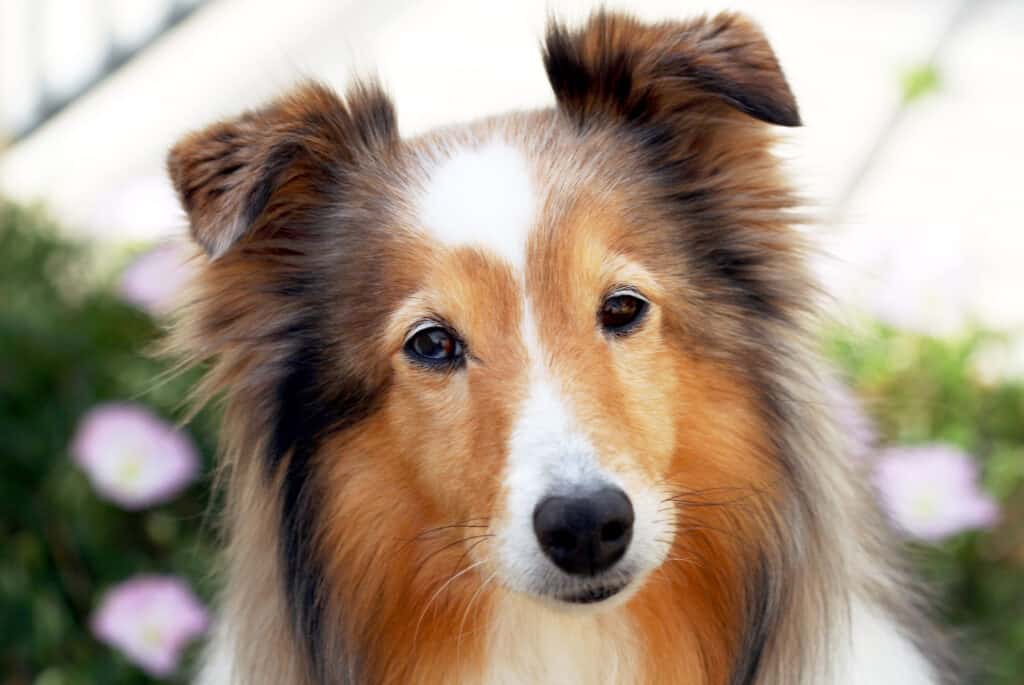Our website is supported by our users. We sometimes earn money when you click an affiliate link and make a purchase. This is at no extra cost to you and helps us to create quality content. For all that have shown us such wonderful support, we thank you from the bottom of our hearts!
The Shetland Sheepdog, affectionately known as the Sheltie, or Sheltie dog, is a small, agile dog breed renowned for its proficiency in herding and its origins from the Shetland Islands of Scotland.
These intelligent and energetic dogs have captivated the hearts of many with their luscious coat, expressive eyes, and spirited nature.
Their history dates back to the 20th century, where they were first used for herding sheep and ponies on the rugged terrain of their homeland, displaying remarkable obedience and agility.

Shelties possess a striking physical resemblance to their larger cousin, the Rough Collie, and are admired for their double coat consisting of a dense, soft undercoat and a long, straight, and harsh outer coat.
They are often mistaken for miniature collies.
The breed shows a remarkable aptitude for training, exhibiting a pleasing personality and a keenness to perform tasks and please their owners.
This makes them excellent companions for families and valuable participants in dog sports.
Key Takeaways
- Shelties are intelligent herding dogs originating from Scotland.
- They are known for their striking coat and trainable nature.
- Their history and qualities make them versatile and affectionate pets.
History of the Shetland Sheepdog
Shetland Sheepdogs, affectionately known as Shelties, hail from the rugged Shetland Islands of Scotland.
As their name suggests, they were bred for herding sheep and other animals, working closely with farmers to manage livestock.
This intelligent and nimble breed shares ancestry with their larger cousin, the Collie, and their history on the islands dates back to the 20th century.
Breeding practices in Scotland were influenced by the islands’ harsh climate and the farmers’ needs, eventually leading to the development of the Sheltie’s distinct traits.
These small yet robust dogs were ideal for the farmland’s terrain.
As they gained popularity, Shelties began to appear in England, where breeders sought to refine the breed further.
The American Kennel Club recognized the Shetland Sheepdog as a distinct breed in the early 20th century.
Despite their recognition, controversy arose due to their original name, “Shetland Collie,” which ruffled the feathers of Rough Collie breeders.
This led to their official designation as “Shetland Sheepdogs.”
Your Sheltie’s ancestors played a critical role in the Shetland Islands’ rural community.
They were valued for their hardworking nature and their ability to withstand the Scottish terrain.
Echoes of their history can be seen in Shelties today, with the breed retaining many of the characteristics that made them indispensable to the Shetlanders.
To appreciate the diminutive stature of your Sheltie, look to their origin: the breed was scaled down to suit the Shetland Islands’ modest size and to be a companionable pet for families.
Their legacy continues to be celebrated by enthusiasts across the globe, cementing their place in Shetland Sheepdog history.
Physical Characteristics of the Shetland Sheepdog

The Shetland Sheepdog, often resembling a smaller version of a collie, boasts a physique showing intelligence, agility, and an active nature.
These dogs are known for their athletic build, dense double coat, and sharp agility.
Height Male
Males typically stand between 13 and 16 inches at the shoulder.
Height Female
Females, slightly smaller on average, also range from 13 to 16 inches in height.
Weight Male
A healthy male Sheltie usually weighs between 15 to 25 pounds.
Weight Female
Females tend to be lighter, with weights also ranging from 15 to 25 pounds.
Eye Colors
Your Shetland Sheepdog might have dark brown eyes, although blue eyes can occur, particularly in the blue merle variety.
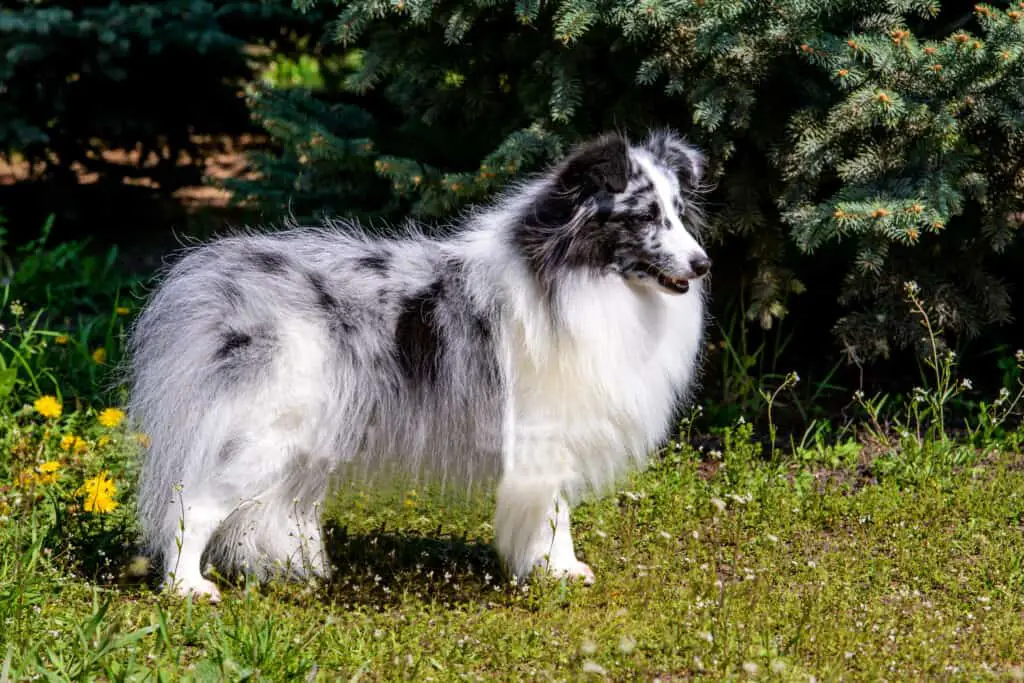
Coat Colors
You’ll find a vibrant variety of coat colors in this breed, including sable, black, blue merle, and combinations with white and tan.
Coat Types
The breed is adorned with a long double coat; a harsh, straight outer coat paired with a dense undercoat for insulation.
Body
The body of a Shetland Sheepdog is muscular and compact, reflecting their quick and active nature.
They typically have upright ears which add to their keen expression.
These dogs are truly athletic, designed for activity and marked by their historic agility and intelligence.
Their coat requires regular maintenance, and their size makes them a comfortable fit for most homes, not being too large like a collie or too petite like a King Charles Spaniel.
Life Expectancy

When caring for your Shetland Sheepdog, it’s important to understand how long they may be a part of your life.
The average lifespan of a Shetland Sheepdog is generally between 12 to 15 years.
This longevity can be attributed to the breed’s generally active nature and robust health when well cared for.
To ensure your Sheltie enjoys a full lifespan, focus on providing:
- Proper nutrition: A balanced diet tailored to their specific life stage.
- Regular exercise: Shelties are active dogs and require daily physical activity.
- Routine veterinary care: Regular check-ups can help detect and manage health issues early.
Maintaining an active lifestyle for your Shetland Sheepdog not only contributes to their physical health but mental stimulation as well, which is crucial for this intelligent breed.
Keep them engaged with various activities and training exercises to promote their overall well-being.
By understanding and addressing the factors within your control, such as diet, exercise, and health care, you help set the stage for a long and happy life for your Sheltie companion.
Overview of the Physical Characteristics of the Shetland Sheepdog
The Shetland Sheepdog, affectionately known as the Sheltie, boasts an appearance that may remind you
Temperament & Training of the Shetland Sheepdog
The Shetland Sheepdog, commonly referred to as the ‘Sheltie’, is a breed that encapsulates intelligence and a gentle spirit.
As a herding dog with roots in Scotland’s Shetland Islands, your Sheltie is highly active and capable of extensive obedience and herding tasks, making it a versatile family pet.
Intelligence:
- Shelties rank high in intelligence, which makes them remarkably smart in obedience training.
- Their sharp minds require plenty of mental stimulation to avoid boredom.
Training:
- Socialization should begin early to help your Sheltie overcome any timid qualities.
- Regular obedience training can tap into their intelligence and inherent desire to please you.
- Shelties excel in activities that channel their energy and agility such as tracking and herding.
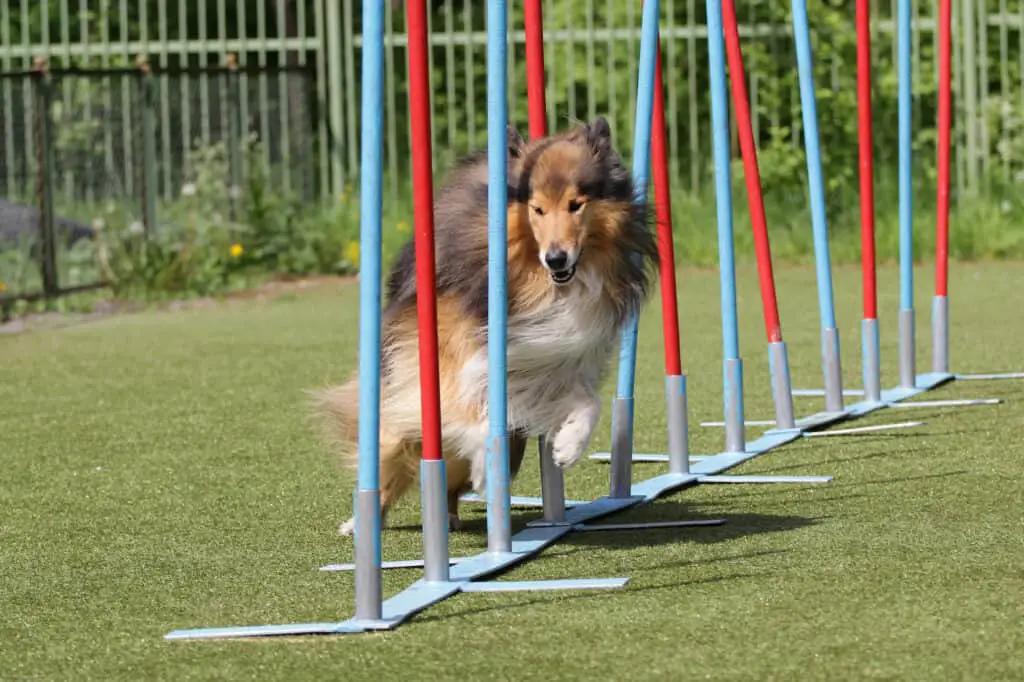
Energy Level & Playfulness:
- Boasting a high energy level, Shelties enjoy engaging play and exercise.
- Their playfulness can be a source of joy and entertainment for the whole family.
Affectionate & Family Dogs:
- They bond deeply, being very affectionate with their humans.
- As family dogs, they are adaptable and make excellent watchdogs without the propensity to nip unless herding instincts kick in.
It’s important to remember that despite their size, Shelties are spirited and thrive when they have a job to do.
Regular engagement in interactive games and training exercises not only keeps them fit but also cements their status as beloved therapy dogs and companions.
When considering the Kennel Club standards and best practices for training, always prioritize kindness and positivity to reinforce their natural tendencies.
With patience and consistent training, your Sheltie’s skills and affectionate nature will undoubtedly shine through.
Health Issues of the Shetland Sheepdog
Shelties are generally healthy, but they do have potential health issues that you should be aware of.
Collie Eye Anomaly (CEA)
Collie Eye Anomaly (CEA), commonly known as the “collie eye defect,” is a hereditary eye condition that can also affect Shetland Sheepdogs.
This genetic disorder involves abnormalities in the development of the eye, particularly the choroid, retina, and optic nerve.
CEA can vary in severity, and affected Shetland Sheepdogs may show no signs or, in more severe cases, experience vision impairment or blindness.
Responsible breeding practices, including genetic testing, play a crucial role in reducing the prevalence of Collie Eye Anomaly in the Shetland Sheepdog population.
Regular veterinary eye examinations are essential for early detection, allowing for appropriate management and care.
While there is no cure for CEA, proactive measures can be taken to support the affected Shetland Sheepdogs and ensure their overall well-being.
Hip Dysplasia
Hip dysplasia is a potential orthopedic concern for Shetland Sheepdogs, a breed known for its intelligence and agility.
This hereditary condition involves an abnormal development of the hip joint, leading to instability and potential joint problems.
Shetland Sheepdogs may be predisposed to hip dysplasia due to genetic factors and their medium-sized build.
Symptoms may include lameness, difficulty rising, and reluctance to engage in physical activities.
While there is no cure for hip dysplasia, management strategies such as weight control, regular exercise, and joint supplements can help improve the dog’s quality of life.
Responsible breeding practices, including screening breeding dogs for hip dysplasia, play a crucial role in reducing the prevalence of this condition in the Shetland Sheepdog population.
Regular veterinary check-ups and early detection contribute to effective management and overall well-being for Shetland Sheepdogs with hip dysplasia.
Allergies
Shetland Sheepdogs can be prone to allergies, a common concern that may manifest as skin irritations, itching, ear infections, or gastrointestinal issues.
Allergies in this breed can result from various factors, including food sensitivities, environmental allergens, or genetic predispositions. Identifying the specific allergen is crucial for effective management.
Shetland Sheepdog owners can implement strategies like hypoallergenic diets, regular grooming to reduce environmental allergens, and providing allergen-free bedding.
Consulting with a veterinarian is essential to determine the best course of action and alleviate discomfort for Shetland Sheepdogs affected by allergies.
Regular veterinary check-ups play a vital role in monitoring and managing allergy-related issues, ensuring the overall health and well-being of these intelligent and affectionate companions.
Thyroid Issues
Thyroid issues can affect Shetland Sheepdogs, potentially leading to conditions like hypothyroidism.
The thyroid gland plays a crucial role in regulating metabolism, and when it malfunctions, it can result in symptoms such as weight gain, lethargy, and skin problems.
Shetland Sheepdogs may be predisposed to thyroid issues, and while genetics can play a role, environmental factors may also contribute.
Regular veterinary check-ups that include thyroid function tests are essential for early detection and effective management of thyroid disorders.
Treatment often involves daily medication of thyroid hormone replacement therapy, which can help alleviate symptoms and improve the overall well-being of affected Shetland Sheepdogs.
Responsible breeding practices and awareness of potential genetic predispositions contribute to minimizing the risk of thyroid issues in the Shetland Sheepdog population.
Von Willebrand’s Disease (vWD)
Von Willebrand’s Disease (vWD), a genetic bleeding disorder, is a potential concern in Shetland Sheepdogs.
This inherited condition is characterized by a deficiency or dysfunction of von Willebrand factor, a protein crucial for blood clotting. Shetland Sheepdogs with vWD may experience prolonged bleeding after injuries, surgeries, or even during routine activities.
Responsible breeding practices, including genetic testing, are essential for identifying carriers of the vWD gene and reducing the prevalence of this disorder in the Shetland Sheepdog population.
While there is no cure for vWD, affected dogs can lead normal lives with proper management.
Veterinary care, including monitoring and prompt intervention during bleeding episodes, is crucial to ensure the well-being of Shetland Sheepdogs with von Willebrand Disease.
Grooming Your Shetland Sheepdog
Grooming your Shetland Sheepdog is essential for maintaining their long, double coat and ensuring they are comfortable during play and exercise.
Regular grooming reduces shedding and prevents matting, especially important in cold weather.
Brushing
You’ll want to brush your Sheltie several times a week due to their dense undercoat and tendency to shed. Use a wide detangling comb and slicker brush to remove loose fur and prevent mats.
Remember that line brushing – parting the coat and brushing layer by layer – is the most effective method for this breed. Their coats can even give a professional groomer a run for their money.
Bathing
Bathe your dog only when needed to avoid stripping natural oils from their coat.
It’s recommended to thoroughly brush the coat before bathing to remove tangles.
Use a dog-specific shampoo and make sure to dry their fur completely to prevent any matting.
We like this ELEGX massager because it really gets the soap down through all your dog’s thick fur.
Cutting Fur/Hair
Trimming or cutting the hair around their paws and ears can keep your Sheltie looking neat.
Pay special attention to the paws to prevent debris from accumulating, which could lead to discomfort during their playful activities.
Clipping or Grinding Nails
Keeping your Sheltie’s nails short is pivotal for their comfort and health.
Whether you use nail clippers or a grinder, be sure to do this task carefully to avoid cutting the quick.
Clip or grind their nails as needed, usually once or twice a month, being careful not to cut into the quick, which can cause bleeding.
If you accidentally cut the quick, dip their nails in Styptic Powder.
To help you learn this procedure, check out our article on How to Grind Your Dog’s Nails or How to Clip Your Dog’s Nails Safely.
Dental Care
Incorporate dental care into your grooming routine by brushing your Sheltie’s teeth regularly.
This will help prevent dental issues and promote overall health.
Use a dog specific toothbrush and toothpaste and aim for several times a week.
Start them as young as possible to desensitize them to the procedure.
Cleaning Ears
Check and clean your Shetland Sheepdog’s ears frequently to prevent infections.
Use a vet-approved ear cleaner and gently wipe out the ear without inserting anything deep into the ear canal.
To make things easier, we use these Pet MD – Dog Ear Cleaner Wipes – Otic Cleanser for Dogs.
Owning a Shetland Sheepdog
When you consider bringing a Shetland Sheepdog into your life, understanding the financial commitment and what it takes to provide a happy home is crucial.
These intelligent dogs are a joy as family pets, but they come with responsibilities that go beyond love and affection.
Cost of Purchase
The initial cost of purchasing a Shetland Sheepdog can vary widely.
Prices typically range from $800 to $1,200 in the United States, but they can be higher depending on the dog’s pedigree and the reputable breeder you choose.
Puppies from champions’ bloodlines can command prices well above this average.
Maintenance Costs
In terms of maintenance costs, being an active breed, a Sheltie will require quality food to maintain their energy levels, which can average around $30 to $60 per month.
Don’t forget routine veterinary care, which can amount to $200 to $500 annually, and that may not include emergency medical expenses.
Basic supplies like a leash, comfortable bedding, and toys also contribute to the maintenance costs.
Additionally, investing in dog education or training can help curb their instinctive barking and herding instincts.
Adopting a Shetland Sheepdog
Alternatively, adopting a Sheltie from a rescue can be a fulfilling way to provide a home to a dog in need.
Adoption fees are generally less than purchasing a puppy and usually cover the cost of spaying/neutering, vaccinations, and microchipping.
The American Shetland Sheepdog Association can guide you toward regional rescue groups.
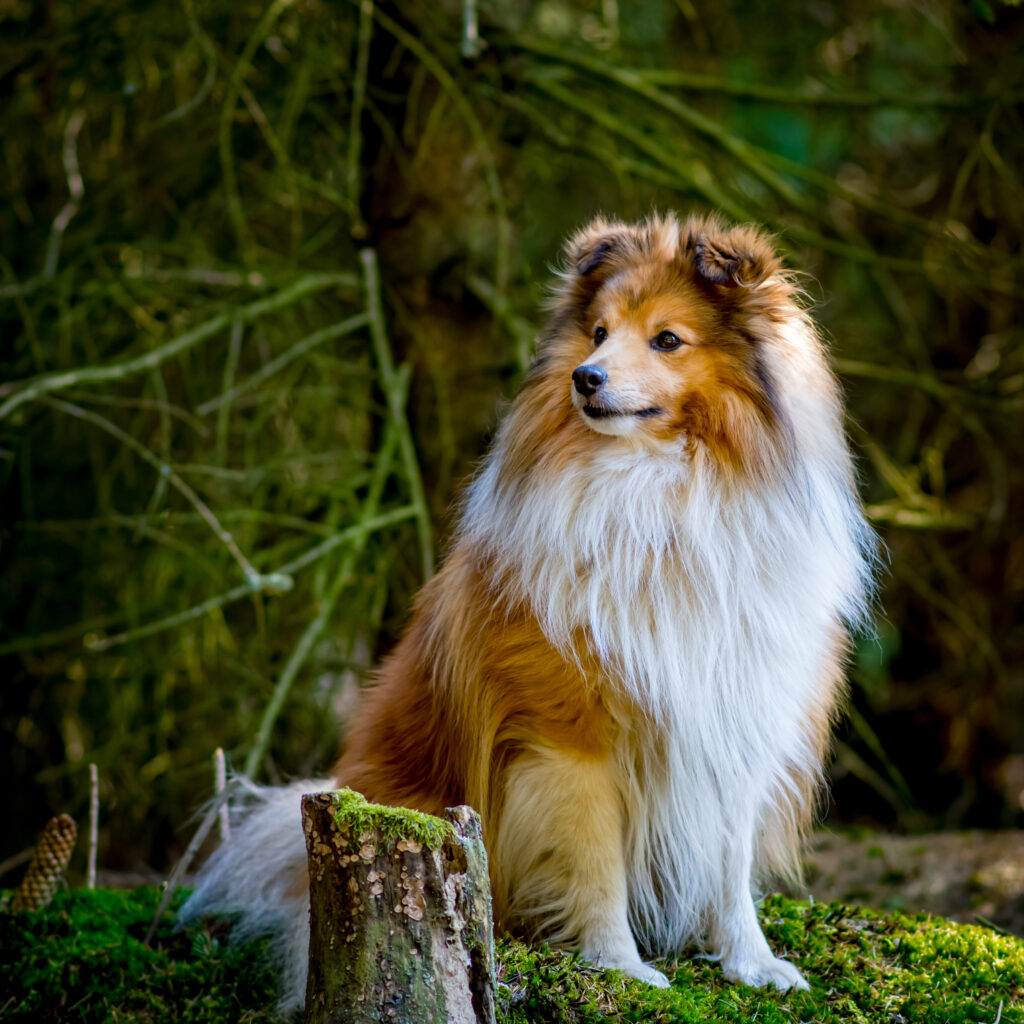
Finding Reputable Breeders
Finding a reputable breeder is paramount when buying the right puppy.
They should be knowledgeable about the breed, including their exercise requirements, tendency for “Sheltie talk,” and how they adapt to living environments including apartments.
You should look for breeders who provide health clearances and are willing to discuss the dog’s lineage and potential hereditary issues.
Frequently Asked Questions

In this section, you’ll find precise answers to common inquiries about the Shetland Sheepdog, a breed known for its intelligence and suitability for family life.
How long do Shetland Sheepdogs typically live?
Shetland Sheepdogs have a life expectancy of around 12 to 14 years, which can extend with proper care and a healthy lifestyle.
What is the average size and weight of a Shetland Sheepdog?
Your Shetland Sheepdog will likely stand 13 to 16 inches tall at the shoulder and weigh between 15 to 25 pounds when fully grown.
How much grooming do Shetland Sheepdogs require?
Due to their long and flowing double-coat, Shetland Sheepdogs require regular grooming several times a week to prevent matting and maintain coat health.
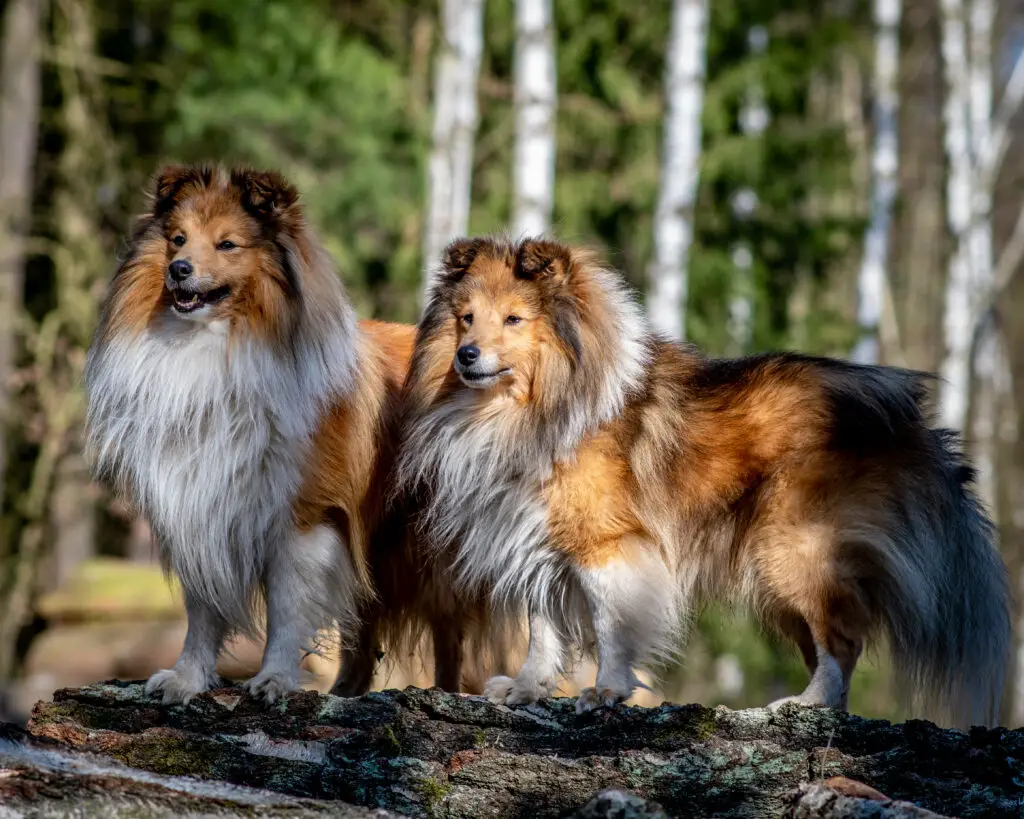
Compared to Collies, what are the distinct characteristics of Shetland Sheepdogs?
While resembling the Rough Collie in appearance, Shetland Sheepdogs are a distinct breed, typically smaller with a more reserved and sensitive temperament.
What is the intelligence level of Shetland Sheepdogs, and how are they in training?
Shetland Sheepdogs are ranked as one of the most intelligent dog breeds, excelling in obedience training and enjoying the challenge of learning new commands and tricks.
How suitable are Shetland Sheepdogs for a family environment?
They thrive in family settings, being playful, observant, and affectionate, but require early socialization to develop confidence and prevent shyness.
Conclusion: Bottom Line on the Shetland Sheepdog

Your exploration of the Shetland Sheepdog, or Sheltie, reveals a breed that embodies both activity and gentility.
Typically known for their high energy, Shelties fit well with active individuals and families seeking a four-legged companion that can keep pace with a dynamic lifestyle.
As a herding breed, their lineage traces back to the robust Shetland ponies, and this history is evident in their stamina and work ethic.
Their kind temperament makes them an excellent choice for a family pet, forming strong bonds and often being particularly gentle and patient with children.
In terms of health issues, you should be aware that this breed may be susceptible to certain genetic conditions.
Regular veterinary check-ups are recommended to monitor and maintain their wellbeing. With regard to training, you’ll find Shelties to be impressively intelligent and eager to please, which can make training a rewarding experience.
However, don’t underestimate the importance of early socialization and consistent positive reinforcement techniques.
When committing to a Sheltie, you can expect a faithful and devoted pet.
Your readiness to provide exercise, mental stimulation, and companionship will set the foundation for a harmonious relationship with your Sheltie, ensuring they lead a healthy, happy, and fulfilled life by your side.
Please read our Legal Disclaimer

